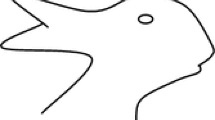Abstract
A theory consists of a mental model, laws that specify parameters of the model and one or more explanatory schemas. Models represent by being isomorphic to real systems. To explain an event is to reenact its genesis by executing the relevant model in the mind's eye. Schemas capture recurring structural features of explanations. To subscribe to a theory is to be committed to explaining a particular class of events with that theory (and nothing else). Given theoretical commitment, an anomaly, i.e., an event that cannot be explained, is an occasion for theory change, but in the absence of commitment, the response is instead to exclude the anomalous event from the domain of application of the theory. Lay people and children hold their theories implicitly and hence without commitment. These observations imply that the analogy between scientist's theories and children's knowledge is valid, but that the analogy between theory change and learning is not.
Similar content being viewed by others
REFERENCES
Cartwright, N.: 1983, How the Laws of Physics Lie, Oxford University Press, Oxford, UK.
Clement, J.: 1982, 'Students' Preconceptions in Introductory Mechanics', American Journal of Physics 50, 66–71.
Confrey, J.: 1990, 'A Review of Research on Student Conceptions in Mathematics, Science, and Programming', in C. B. Cazdan (ed.), Review of Research in Education, American Educational Research Association, Washington D.C., 16, 3–56.
Feynman, R.: 1967, The Character of Physical Law, MIT Press, Cambridge, MA.
Gentner, D. & Stevens, A. L. (eds.): 1983, Mental Models, Erlbaum, Hillsdale, NJ.
Giere, R. N. (ed.): 1992, Cognitive Models of Science, University of Minnesota Press, Minneapolis, MN.
Gopnik, A.: 1996, 'The Scientist as Child', Philosophy of Science, 63, 485–514.
Gopnik, A. & Wellman, H. M.: 1994, 'The Theory Theory', in L. A. Hirschfeld and S. A. Gelman (eds.), Mapping the Mind: Domain Specificity in Cognition and Culture, Cambridge University Press, Cambridge, UK, 255–293.
Halloun, I. A. & Hestenes, D.: 1985, 'Common Sense Concepts about Motion', American Journal of Physics 53, 1056–1065.
Harris, P. L.: 1994, 'Thinking by Children and Scientists: False Analogies and Neglected Similarities', in L. A. Hirschfeld & S. A. Gelman (eds.), Mapping the Mind: Domain Specificity in Cognition and Culture, Cambridge University Press, Cambridge, UK, 294–315.
Hempel, C. G. & Oppenheimer, P.: 1948, 'Studies in the Logic of Explanation', Philosophy of Science 15, 135–175.
Hewson, P. W. & A'Beckett Hewson, M.: 1984, 'The Role of Conceptual Conflict in Conceptual Change and the Design of Science Instruction', Instructional Science 13, 1–13.
Kitcher, P.: 1993, The Advancement of Science, Oxford University Press, New York.
Kuhn, T. S.: 1970, The Structure of Scientific Revolutions (2n ed.), University of Chicago Press, Chicago, IL.
McCloskey, M.: 1983, 'Naive Theories of Motion', in D. Gentner & A. L. Stevens (eds.), Mental Models, Erlbaum, Hillsdale, NJ, 299–323.
Ohlsson, S.: 1992, 'The Cognitive Skill of Theory Articulation: A Neglected Aspect of Science Education?', Science & Education, 1, 181–192.
Ohlsson, S.: 1993, 'Abstract Schemas', Educational Psychologist 28, 51–66.
Ohlsson, S.: 1995, 'Learning to Do and Learning to Understand: A Lesson and a Challenge for Cognitive Modeling', in P. Reimann and H. Spada (eds.), Learning in Humans and Machines: Towards an Interdisciplinary Learning Science, Elsevier, Oxford, UK.
Ohlsson, S. & Bee, N.: 1991, 'Radical Strategy Variability: A Challenge to Models of Procedural Learning', in L. Birnbaum (ed.), Proceedings of the International Conference of the Learning Sciences, Northwestern University, August 4–7, 351–356.
Ohlsson, S. & Lehtinen, E.: 1997, 'Abstraction and the Acquisition of Complex Ideas', International Journal of Educational Research 27, 37–48.
Polanyi, M.: 1969, Knowing and Being, University of Chicago Press, Chicago, IL.
Polanyi, M.: 1958/1973, Personal Knowledge, Routledge & Kegan Paul, London, UK.
Posner, G., Strike, K. A., Hewson, P. W. & Gertzog, W. A.: 1982, 'Accomodation of a Scientific Conception: Toward a Theory of Conceptual Change', Science Education 66, 211–227.
Robin, N. & Ohlsson, S.: 1989, 'Impetus Then and Now: A Detailed Comparison between Jean Buridan and a Single Contemporary Subject', in D. E. Herget (ed.), The History and Philosophy of Science in Science Teaching, Florida State University, Tallahassee, FL, 292–305.
Salmon, W. C.: 1990, Four Decades of Scientific Explanation, University of Minnesota Press, Minneapolis, MN.
Schank, R. C.: 1986, Explanation Patterns, Erlbaum, Hillsdale, NJ.
Sheldrake, R.: 1988, The Presence of the Past: Morphic Resonance and the Habits of Nature, Times Books, New York.
Siegler, R. S. & Stern, E.: in press, 'Conscious and Unconscious Strategy Discoveries: A Microgenetic Analysis', Journal of Experimental Psychology: General.
Smith, III, J. P., DiSessa, A. A. & Roschelle, J.: 1993, 'Misconceptions Reconceived: A Constructivist Analysis of Knowledge in Transition', The Journal of the Learning Sciences 3, 115–163.
Stadler, M. A. & Frensch, P. A. (eds.): 1998, Handbook of Implicit Learning, SAGE, Thousand Oaks, CA.
Strike, K. A. & Posner, G. J.: 1985, 'A Conceptual Change View of Learning and Understanding', in L. West and L. Pines (eds.), Cognitive Structure and Conceptual Change, Academic Press, New York, 211–231.
Strike, K. A. & Posner, G. J.: 1992, 'A Revisionist Theory of Conceptual Change', in R. A. Duschl and R. J. Hamilton (eds.), Philosophy of Science, Cognitive Psychology, and Educational Theory and Practice, State University of New York Press, New York, 147–176.
Suppe, F.: 1989, The Semantic Conception of Theories and Scientific Realism, University of Illinois Press, Urbana, IL.
Thijs, G. D. & Van Den Berg, E.: 1995, 'Cultural Factors in the Origin and Remediation of Alternative Conceptions in Physics', Science & Education 4, 317–347.
Thompson, P.: 1989, The Structure of Biological Theories, State University of New York Press, New York.
Vosniadou, S.: 1994, 'Capturing and Modeling the Process of Conceptual Change', Learning and Instruction 4, 45–69.
Vosniadou, S. & Brewer, W. F.: 1994, 'Mental Models of the Day/Night Cycle', Cognitive Science 18, 123–183.
Author information
Authors and Affiliations
Rights and permissions
About this article
Cite this article
Ohlsson, S. Theoretical Commitment and Implicit Knowledge: Why Anomalies do not Trigger Learning. Science & Education 8, 559–574 (1999). https://doi.org/10.1023/A:1008604626856
Issue Date:
DOI: https://doi.org/10.1023/A:1008604626856




